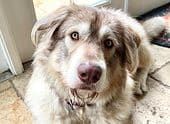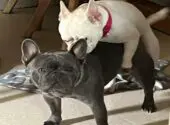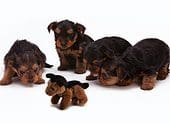Are you looking to add an extra member to your family? Do you want a pet that can co-exist with the pets you already have at home? If so, get an American Alsatian.
These gentle giant thrives well in multi-pet households and rarely attack smaller animals. If the American Alsatian experiences jealousy towards another pet, it does not engage in aggressive behavior or pursue them. Instead, this dog becomes even more affectionate towards his owners, showering them with cuddles and extra attention in an effort to remind them who loves them most.
From its fluffiness to its friendly deameanor, it’s hard to say no to this breed.
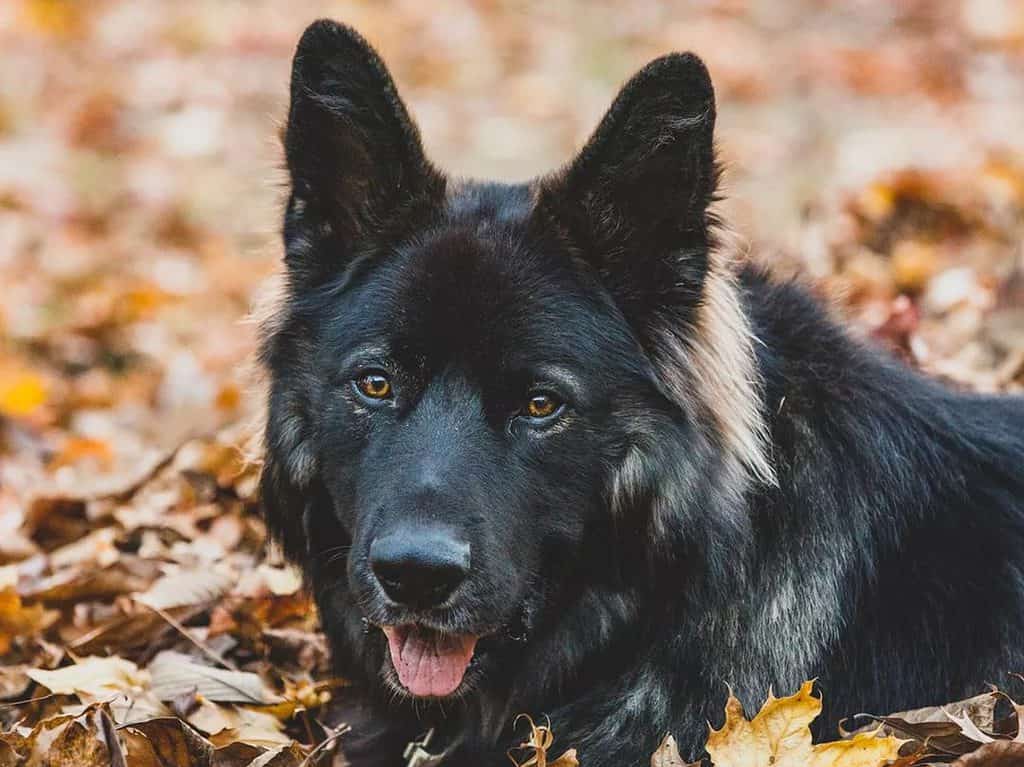
Quick Facts: American Alsatian
Height
30 - 33Weight
90 - 100Lifespan
12 - 15Breed Size
large (61-100 lbs.)Breed Type
purebredBreed Group
companionTemperament
anxious, friendly, gentle, affectionate, intelligentGood With
families, other dogs, cats, strangersIntelligence
highShedding
infrequentExercise Needs
highBarking Level
lowEnergy level
lowDrool Amount
lowCoat Type
long or shortCoat Patterns
bi-colorColors
black, cream, silver, goldOther Characteristics
apartment-friendly, easy to train, good for first-time pet owners, low prey driveAmerican Alsatian Highlights
- The American Alsatian was first formally recognized in 1988 by the North American Shepalute Club, now known as the National American Alsatian Club. Additionally, selective breeding developed the American Alsatian breed into its present-day form.
- It has been specifically bred to be composed and smart. These features facilitate a more pleasant training process when compared to other breeds, which can be problematic in this regard.
- The American Alsatian was selectively bred to mimic the physical characteristics of the now-extinct dire wolf.
- These dogs have impressive coats and large physiques, which may garner considerable attention when someone is the owner of one.
- Americal Alsatians enjoy quality time with their caregivers and are content to remain seated on the sofa and participate in family activities.
History
In 1969, an idea for a new breed of dog became apparent when a mixed German Shepherd dog followed a young child home. At a young age, Lois Schwarz developed a fascination with genetics and commenced to breed various animals in her search for knowledge. She devoted much of her time researching in local libraries. She meticulously documented any observed albinism, mutation, eye shapes, coat density, and coat colors.
At 30, Lois acquired a wealth of experience with numerous animal breeds through her activities as a trainer, groomer, handler, and breeder. She continuously evaluated and acquired information, developing an image of this relatively new large breed of dog Lois wanted to create.
The foundation of the Americal Alsatian (initially called North American Shepalute) consisted of several AKC American Show Shepherds, working German Shepherd Dogs imported from Canada, Holland, and Germany and two purebred Alaskan Malamutes. After ten years of crossbreeding, the resulting breed exhibited a consistent character while resembling its German Shepherd Dog ancestor. During this period, a selection of North American Shepalute dogs known for their calm dispositions was crossbred with a fawn-colored English Mastiff. Lois deliberately selected the English Mastiff breed to acquire a large breed companion dog with a large head and an abundant solid bone structure.
Over several years, a selective breeding process was employed to breed Shepalute Mastiff mixed dogs; only the quietest and boldest of each litter were chosen, which eventually resulted in litters consistently reproducing themselves. In 2002, Lois had predetermined standards for each type of dog, and every litter produced a uniform character and physical appearance.
In 2004, Lois was joined by her daughter Jennifer Stoeckl in her endeavor to create the first large-breed companion dog.
In 2006, further crosses of these dogs with unrelated breeds were conducted. This yielded breeds comprising an Anatolian Great Pyrenees mix from purebred lines and a Shepherd Malamute hybrid. Lois opted to use these two dogs to maintain the size while upgrading the temperament.
Unsatisfied with the feel of the coat and the overall size and structure of American Alsatian canines continuing to evolve, Lois decided to incorporate Irish Wolfhounds and other large-sized Alaskan Malamute breeds.
Over the years, as the distinction between a hybrid and a purebred dog has become clearer, the name associated with this breed has been altered multiple times to reflect its progression from mixed ancestry to distinctiveness.
In 1988, Lois Schwarz opted for a name for the crossbreed of Shepherd and Malamute; this designation evolved into North American Shepalute.
In 2004, the breed was officially renamed Alsatian Shepalute in an effort to emphasize the breed’s heritage, which originates from when German Shepherds were called Alsatian Wolfdogs. It was decided that since this breed closely mirrored the physical characteristics of the Dire Wolf, that would be used as its label.
Finally, in 2010, the breed’s name was formally altered to American Alsatian.
Appearance
The American Alsatian is a large and muscular breed of dog with a distinct head featuring a prominent muzzle and black nose. The ears are typically held upright on their heads in an erect fashion.
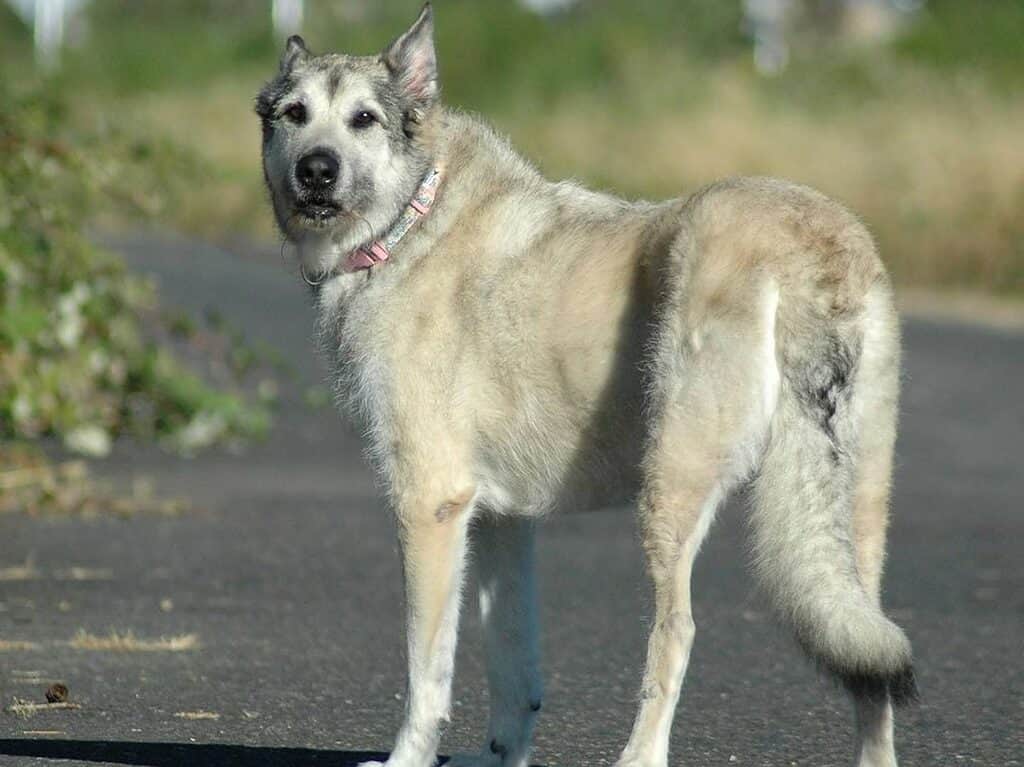
American Alsatian Size
Male American Alsatian adult dogs can reach up to 33 inches in height, whereas their female counterparts tend to be around 30 inches tall.
Also, the weights of American Alsatian dogs vary according to gender; males must weigh at least 100lb, while females should reach a minimum weight of 90lb when fully grown.
American Alsatian Colors
This large dog stands out partly because of its striking coat: cream, black sable, silver, and gold fur.
Coat
American Alsatians have a thick coat to protect them from extreme weather conditions, consisting of two layers dedicated to winter and summer temperatures. The winter coat is characterized by its moderately coarse texture, degree of density, and slightly wooly nature. During the summer months, the American Alsatian typically has a shorter coat due to its tendency to lose most of its undercoat.
Personality
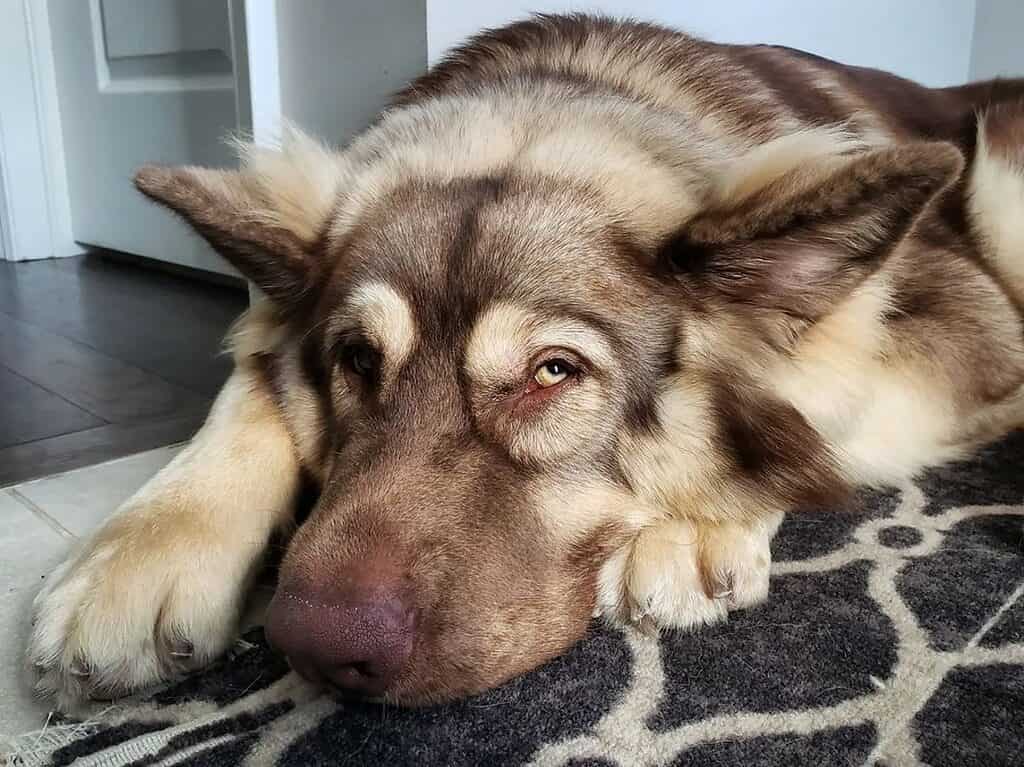
The incorporation of various large breeds into the American Alsatian’s ancestry has led to speculation about how this will manifest in the breed’s physical and temperamental qualities. This section provides a comprehensive overview of the American Alsatian’s behavioral characteristics.
The temperament of an American Alsatian is typically calm, making it unlikely that they will tend to bark loudly. But to create a balanced and reliable canine, you must properly educate your puppy. Additionally, your pup must receive proper socialisation early to become accustomed to interacting with people and other animals.
These dogs are naturally inclined to form close relationships with their owners from a young age. An American Alsatian puppy will often exhibit a strong desire for closeness and contact with its owner; however, this likely does not extend to unfamiliar people.
Unfortunately, due to forming strong attachments with their owners, many American Alsatians struggle when left alone and suffer separation anxiety.
Crate training can help alleviate distress related to separation anxiety. It is beneficial for dog owners to quickly embrace this method and provide their pets with comforting items, such as their favorite toys, in the crate.
Health
Being a new breed, there is currently limited insight into their potential for developing health issues. Nevertheless, we can expect that this breed may be predisposed to health problems common in large dog breeds. These can include bloat, arthritis, seizures, heart problems, allergies, and hip dysplasia.
Lifespan
An American Alsatian has an average life expectancy of 12 to 15 years, which offers the potential of a long-term and committed companion if one is chosen.
Keep in mind that is impossible to determine the precise lifespan of any canine, as numerous elements prior to and during its lifetime can drastically influence it. Despite the assurance that reputable breeders provide regarding the quality of their puppies, there is still a risk of inherited health problems and those that may naturally arise.
Care
The American Alsatian is categorized as a non-sporting canine and does not demand an excessive exercise plan. A short exercise can meet its minimal needs for about an hour of outdoor activity in a garden or recreational area.
Because of their lack of need for a large space to roam, this breed is ideally suited to living in an apartment. Nevertheless, owners can offer stimulating toys to keep them both content and occupied.
Begin training American Alsatian Puppies at 6-7 months for optimal results. It is crucial to train these dogs firmly, utilizing abundant praises, caresses, and other forms of reinforcement in addition to altering intonation or word choice while delivering commands.
Diet
Begin with high-grade puppy food and progress from there. It is important to allow the puppy ample opportunity to consume as much food as it desires until its appetite is satiated. Any leftover food in the dog’s bowl should not be thrown away. Instead, additional ingredients and flavors should be incorporated into its next meal.
American Alsatian puppies should consume four meals of high-quality kibble daily, supplemented with safe homemade foods, including Brussels sprouts. When the puppies are six months old, they should be transitioned to three daily feedings.
American Alsatian owners must ensure that their dogs reach 100 pounds by the completion of their first year.
Grooming
During the summer months, one must ensure that their vacuum cleaner is up to par as the American Alsatian possesses a double coat which tends to shed heavily. Reducing the amount of hair spread throughout your home can be facilitated by using a de-shedding brush or comb.
During the winter, brush the American Alsatian’s coat at least twice a week since its shedding is minimal during this period.
Ideally, you should bathe the American Alsatian quarterly or semi-annually to maintain its coat health and natural oils.
American Alsatian Puppies
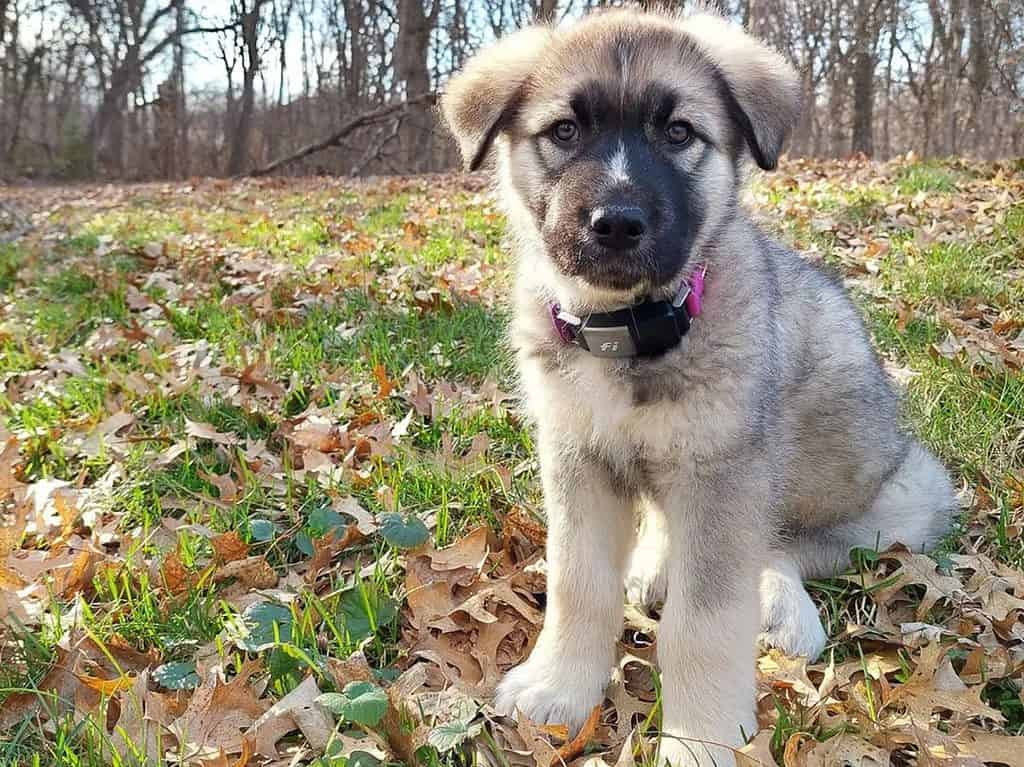
Purchasing a puppy from one of the registered breeders associated with the National American Alsatian Breeders Association is likely to cost $2000 or more.
Children and Other Pets
The American Alsatian has been selectively bred to be friendly and easy-going, exemplifying its giant lap dog identity. This trait allows the breed to mingle with people and coexist with other companion animals.
The American Alsatian has a reduced tendency to prey on smaller animals and does not perceive them as an inherent threat. However, if this breed perceives its owner is exhibiting more affection towards another pet, it can become exceedingly jealous.
Parents should emphasize to their children that this dog requires space when it is time for rest or sleep. They must refrain from disturbing the pup during such times. Once it awakens, however, all interactions with it can resume.
Rescue Groups
Although the American Alsatians have earned a reputation as being great family companions who are gentle with children, there is currently no formal rescue system set up specifically for them, leaving many people without anywhere to turn when looking for assistance when trying to adopt or rehome one of these dogs.
American Alsatian FAQS
Is the American Alsatian an effective guard dog?
If you buy an American Alsatian, keep in mind that this breed is not suited for the role of a guard dog. However, you will get a caring and devoted companion in exchange.
Are American Alsatians noisy?
The temperament of an American Alsatian is relatively calm, meaning your puppy should not be prone to excessive barking. Nevertheless, consistent training will still be necessary and introducing it to people and other animals from an early age will help ensure that it is comfortable greeting new faces and animals.
Is the American Alsatian high-energy dog?
No. Despite their large size, they are known for being a relaxed breed, preferring lounging around with their human over playing fetch or running around outside.
Is the American Alsatian a purebred dog?
Yes. This is a fifth-generation purebred dog created through successive generations of crossbreeding.
Is the American Alsatian easy to groom?
American Alsatians have minimal grooming needs throughout the year, with the exception of the shedding season (winter).
American Alsatian Fun Facts
- The American Alsatian was carefully bred to resemble the physical form of the now-extinct Dire Wolf, a giant wolf native to North America.
- On February 4, 1988, in Oxnard, California, a litter was whelped between two purebred canines: an Alaskan Malamute (Buddy) and a German Shepherd Dog (Swanny).
- The term Alsatian was given to designate a breed of canine that maintained certain similarities with the physical characteristics of wolves.
- On February 21, 2010, the designation of this particular breed was revised and officially changed to American Alsatian; the former title, Shepalute, was subsequently eliminated.
References
Takeuchi, Y., Houpt, K. A., & Scarlett, J. M. (2000). Evaluation of treatments for separation anxiety in dogs. Journal of the American Veterinary Medical Association, 217(3), 342-345.
Flannigan, G., & Dodman, N. H. (2001). Risk factors and behaviors associated with separation anxiety in dogs. Journal of the American Veterinary Medical Association, 219(4), 460-466.

